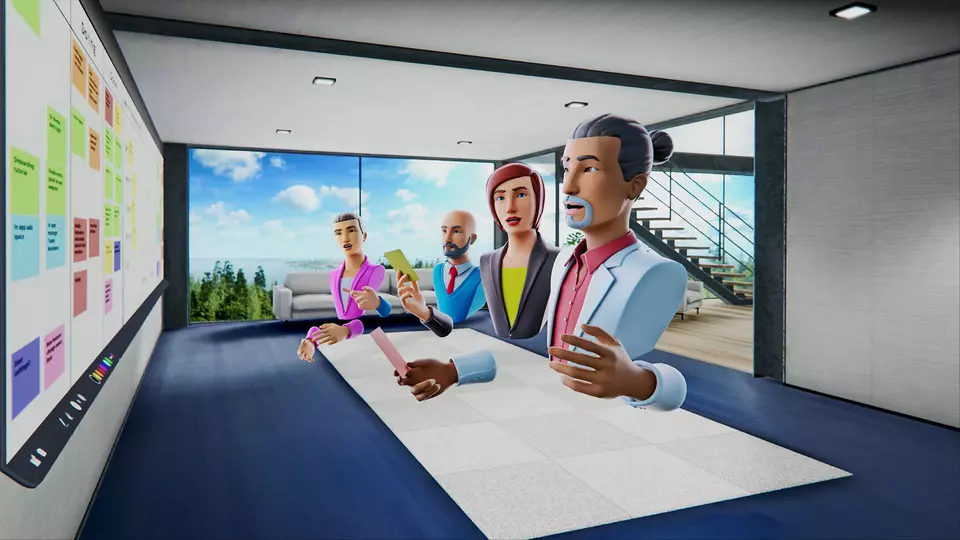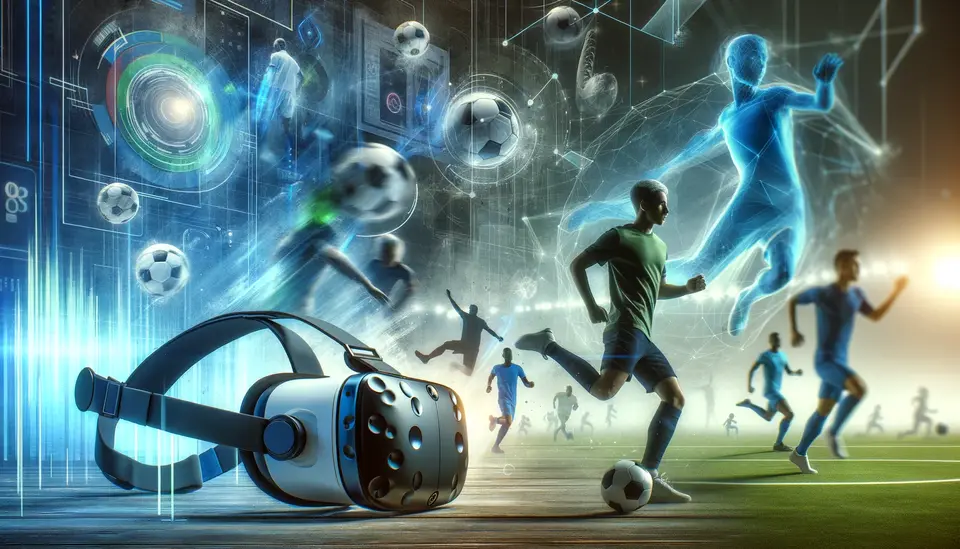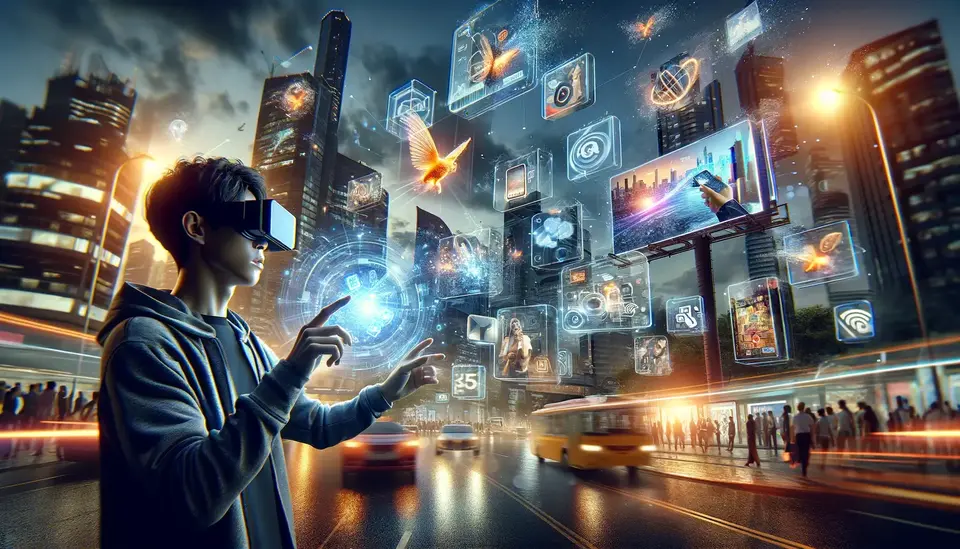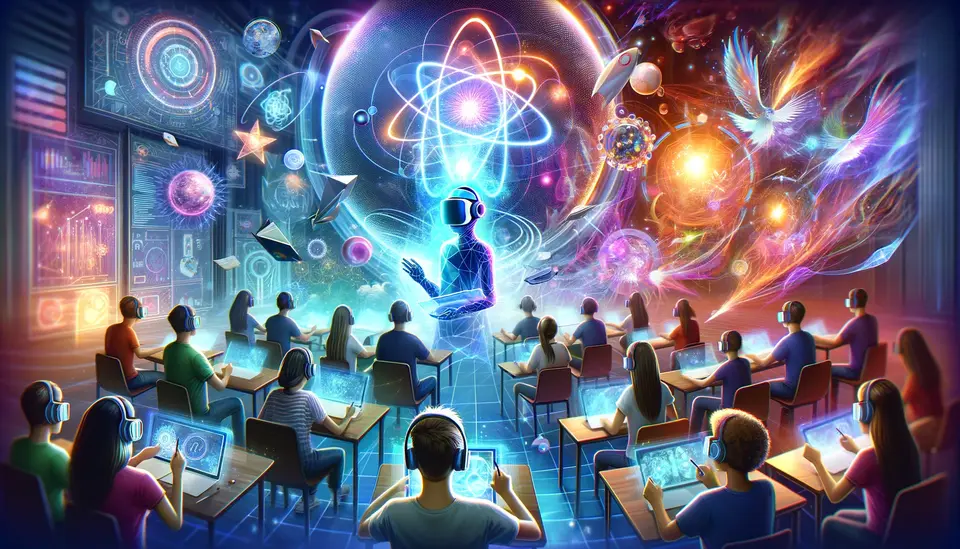Diving Deep into Language: The Benefits of Learning in Virtual Reality (VR)
Posted on September 6, 2023 20 minutes 4231 words
Table of contents
- Introduction: From Textbooks to Virtual Worlds – The Evolution of Language Learning
- 1. Immersive Experience: Beyond the Classroom, Into Virtual Worlds
- 2. Enhanced Engagement and Retention: Making Language Learning Unforgettable
- 3. Personalized Learning: Tailoring Virtual Worlds to Individual Needs
- 4. Cultural Immersion: Beyond Words to the Heart of a Culture
- 5. Access to Native Speakers and Environments: Stepping into Authentic Lingual Territories
- 6. Cost-Effective & Flexible: A New Dawn for Affordable and Customizable Language Learning
- 7. Technological Advantages: Harnessing the Power of Advanced Tech for Linguistic Mastery
- 8. Keeping Learners Motivated: From Enthusiasm to Consistent Engagement
- Conclusion: The Dawn of a Linguistic Renaissance with Virtual Reality
Introduction: From Textbooks to Virtual Worlds – The Evolution of Language Learning
The Journey of Language Acquisition
Ancient Beginnings: In ancient civilizations, language was primarily learned through immersion. Travelers, traders, and scholars would absorb languages by living among native speakers. This direct exposure was organic, though it required significant time and adaptation.
Grammar-Translation Method: Fast forward to the 19th century, formal education systems started adopting the Grammar-Translation method. Rooted in written exercises, this approach prioritized reading and writing. Students would translate sentences or texts from their native language to the target language and vice-versa. It was academically rigorous but often lacked in developing conversational skills.
Audio-Lingual Method: By the mid-20th century, with the advent of audio technology, the focus shifted towards listening and repeating. This method was based on behaviorist theories, emphasizing rote repetition and drills, hoping to instill correct language patterns in learners. Radio broadcasts, tapes, and later CDs became popular tools, allowing learners to mimic native pronunciation and intonation.
Communicative Approach: In the late 20th century, educators recognized the importance of real-life communication. The emphasis was now on interacting and conveying ideas rather than mere translation or repetition. This more holistic method encompassed reading, writing, speaking, and listening, fostering genuine communication skills.
Digital and Online Learning: As the 21st century rolled in, the digital revolution took hold. Language learning apps like Duolingo, Babbel, and Rosetta Stone made lessons interactive and accessible. Online platforms enabled learners to connect with native speakers from around the globe. Multimedia resources, podcasts, and video content offered diverse ways to learn at one’s own pace.
Enter Virtual Reality: The Future of Learning
What is VR?: Virtual Reality, commonly known as VR, offers a simulated experience that can be similar to or completely different from the real world. Using VR headsets, individuals can immerse themselves in a digitally constructed environment.
A New Frontier in Education: While VR was initially popularized by the gaming industry, its potential as an educational tool was quickly recognized. Schools, colleges, and independent educators began exploring VR to teach subjects from history to molecular biology.
Language Learning Reimagined: For language enthusiasts, VR promises an exciting twist to traditional methods. Imagine sitting in a virtual Parisian café, ordering in French, and chatting with the locals, all from the comfort of your home. Or wandering through a digital market in Beijing, practicing Mandarin as you haggle with shopkeepers. VR offers a level of immersion that no textbook or app can replicate.
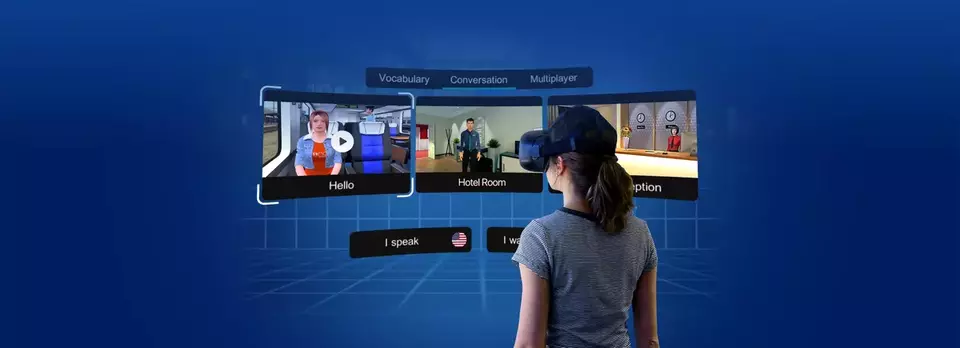
1. Immersive Experience: Beyond the Classroom, Into Virtual Worlds
Language learning isn’t just about memorizing vocabulary and grammar rules. It’s about context, culture, interaction, and, most importantly, immersion. Virtual Reality brings all these aspects together in a revolutionary manner, offering learners a bridge to cross the chasm between theoretical knowledge and practical application.
Reality Simulation: The Virtual Passport to Native Surroundings
A World Without Borders: With VR, learners are no longer confined by geographical constraints. Want to practice Japanese? Step into a bustling Tokyo street. Eager to master Italian? Experience the romance of Venice’s canals. These virtual journeys provide not just language, but cultural context, making the learning process richer and more engaging.
Contextual Learning: Words and phrases can change their meanings based on where and how they’re used. By simulating native environments, VR offers learners the ability to understand context. For instance, the Spanish word “taza” means cup. In a virtual Mexican kitchen, learners can see the ’taza’ holding coffee, ingraining the word’s meaning visually and contextually.
A Sensory Experience: Traditional language learning often only engages two senses: sight and hearing. VR taps into a multi-sensory experience. The sound of waves while learning sea-related vocabulary in Spanish, the sight of rain in a German story about weather, or the virtual touch of fabric in a French clothing store all contribute to a deeper, more holistic understanding of the language.
Interactive Scenarios: Practice, Interact, Learn
Active Participation: Unlike passive listening or reading exercises, VR thrusts learners into active scenarios. Ordering food in a Parisian café, asking for directions in downtown Beijing, or attending a virtual Spanish wedding forces learners to apply their knowledge on-the-fly, strengthening recall and fluency.
Role-Playing for Mastery: VR can simulate a plethora of social interactions. From being a shop owner dealing with various customers to being a traveler asking about train schedules, these role-playing exercises provide diverse and authentic situations for learners to flex their language muscles.
Immediate Feedback: Many advanced VR language platforms incorporate real-time feedback. If you pronounce a word wrong or use incorrect grammar during an interaction, the virtual character might not understand, prompting you to correct and learn from your mistakes. This immediate feedback loop is invaluable in honing linguistic skills.
Building Confidence: The fear of making mistakes often deters learners from speaking. In the virtual realm, this fear diminishes. Interacting with virtual characters allows learners to practice without the apprehension of judgment, gradually building their confidence for real-world interactions.
In conclusion, the immersive experiences offered by VR are unparalleled in bridging the gap between theoretical language study and its practical, real-world application. It’s not just about learning a language; it’s about living it.
2. Enhanced Engagement and Retention: Making Language Learning Unforgettable
The human brain is an intricate web of connections, and the manner in which it retains information is heavily influenced by engagement and emotion. Traditional methods of learning a language, while effective, often miss the dynamic experiences that drive deeper memory formation. This is where VR’s capabilities truly shine, transforming abstract lessons into tangible experiences.
Interactive Learning: The Power of Doing
Hands-on Learning: It’s one thing to memorize the word “dance” in Spanish (“bailar”) and another to actually be in a virtual Spanish fiesta, dancing to the rhythm and hearing the word in context. This kind of hands-on, active participation promotes better comprehension and memory retention.
Engaging Multiple Learning Styles: Everyone has their own unique learning style—some are visual learners, some auditory, and some kinesthetic. VR uniquely engages all these styles simultaneously. You can see the word’s representation, hear its pronunciation, and virtually interact with it, catering to a broad spectrum of learners.
Problem-Solving in Real-Time: In VR, if you can’t recall a word or phrase, you can’t advance in certain scenarios. This element of challenge, where learners must recall and apply their knowledge to proceed, encourages critical thinking and problem-solving, reinforcing the learning process.
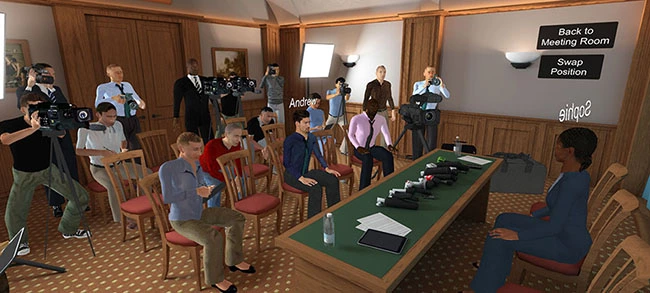
Emotional Connection: Anchoring Language with Feelings
Memory and Emotion: Scientific studies have shown that our most vivid memories are often tied to strong emotions. Think about your most enduring memories—they’re likely linked to moments of high emotion, be it joy, sadness, fear, or excitement. VR can simulate scenarios that elicit such emotions, like the thrill of virtually paragliding over the Swiss Alps while learning German or the serenity of wandering through a virtual Japanese Zen garden. These emotions act as anchors, making vocabulary and grammar learned in these contexts harder to forget.
Creating Personal Experiences: Personal experiences always leave a lasting mark. VR facilitates these by letting learners virtually live out scenarios. Imagine a virtual family dinner in Italy, where you, as the learner, experience the warmth, the laughter, the food, and the language all at once. Such personal experiences can deeply embed linguistic lessons.
Empathy and Cultural Connection: Beyond just words, understanding the cultural nuances and emotions of native speakers can lead to deeper language retention. Experiencing a virtual Day of the Dead celebration in Mexico or joining a virtual Chinese New Year parade allows learners to connect emotionally with the culture, enhancing their language understanding and retention.
In essence, Virtual Reality doesn’t just teach; it immerses and involves, evoking emotions and experiences that make language learning not just an academic exercise, but a journey filled with memories. It’s this emotional and interactive depth that boosts engagement and ensures that lessons learned in the virtual realm are not easily forgotten in the real world.
3. Personalized Learning: Tailoring Virtual Worlds to Individual Needs
One size does not fit all, especially in the realm of education. Everyone has their own pace, strengths, weaknesses, and preferences when it comes to learning. In traditional settings, personalization can be challenging to achieve. However, VR, with its tech-driven foundation and immersive capabilities, is perfectly poised to offer individualized learning experiences that cater to the unique needs of every learner.
Adaptive Platforms: Curating Unique Learning Pathways
Dynamic Difficulty Scaling: Just as video games adjust their challenge level based on a player’s skill, many VR language platforms are designed to gauge a user’s proficiency and adjust the difficulty accordingly. For instance, beginners might start in a virtual environment with simple vocabulary and sentences, while advanced learners might find themselves in complex discussions or debates in the target language.
Immediate Feedback and Recommendations: Beyond just static lessons, VR platforms can provide real-time feedback. If a learner struggles with pronunciation, the platform can pick up on it and recommend exercises specifically tailored to improve that aspect. Similarly, strengths can be identified and further enhanced through targeted activities.
Customizable Interests and Preferences: Everyone has topics they’re passionate about. A film enthusiast might want to delve deep into movie-related vocabulary, while a food lover might prioritize culinary terms. Many VR language platforms allow for these interests to be incorporated, ensuring that learners remain engaged and invested in the subjects they’re exploring.
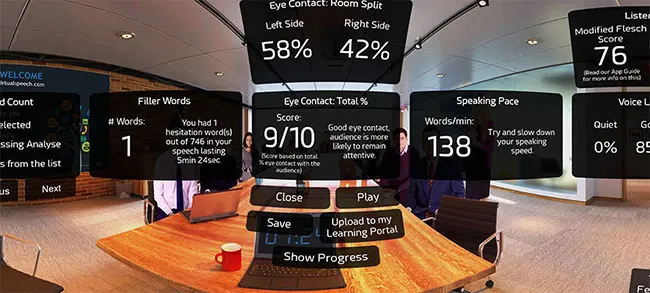
Safe Space for Mistakes: Cultivating Confidence through Trial and Error
Judgment-Free Zone: One of the most significant barriers to language learning is the fear of making mistakes in front of others. VR offers a space where learners can practice, stumble, and correct themselves without any fear of judgment. This freedom to make errors, often considered an essential part of the learning process, ensures that learners can practice without inhibition.
Repetitive Practice: If a particular scenario proves challenging, VR allows for repetition until mastery is achieved. Whether it’s perfecting the order at a virtual French bakery or repeatedly practicing a tricky Japanese phrase, the virtual environment is always patient and ready for one more try.
Building Real-World Confidence: As learners make mistakes and correct them in the VR world, they become more assured of their capabilities. This confidence, built in a safe environment, often translates to real-world situations. Users who have faced and overcome challenges in VR are likely to be more confident when speaking the language outside the virtual realm.
In conclusion, Virtual Reality offers an innovative approach to personalized learning. By adapting to individual needs and offering a secure environment to practice and refine skills, VR ensures that every learner can embark on a language journey tailored just for them, optimizing outcomes and boosting confidence.
4. Cultural Immersion: Beyond Words to the Heart of a Culture
Language is more than just words and syntax; it’s a gateway to understanding a culture’s essence. Without the cultural context, language can sometimes be void of its deeper meanings and nuances. This is where Virtual Reality shines brightest, offering learners not just the tools to speak a language but to deeply connect with its cultural heartbeat.
Understanding Context: More than Just Vocabulary
The Fabric of Culture: Every language carries with it the weight of its history, values, and societal norms. Words might have stories behind them, idioms can reflect cultural attitudes, and the way people speak can reveal much about their values and priorities. VR allows users to dive deep into these narratives, providing context that textbooks might miss.
Non-verbal Communication: In many cultures, what’s unsaid is as crucial as what’s said. From the Italian hand gestures to the respectful bows in Japan, non-verbal cues play a pivotal role in communication. VR, with its immersive nature, can effectively teach these nuances, ensuring learners don’t just speak but also “act” appropriately in cultural contexts.
Celebrations and Traditions: Participating in a virtual Spanish “Fiesta” or experiencing the vibrant colors of India’s “Holi” festival can impart cultural lessons no book can convey. VR platforms can simulate these events, allowing learners to partake in global celebrations, understanding the language’s role in these traditions.
Virtual Tours: A Passport to the World’s Wonders
Landmarks and Historical Sites: Want to learn French? What better way than to take a virtual tour of the Eiffel Tower or the Louvre? Such tours not only teach vocabulary but also offer historical and cultural insights. By walking through Germany’s Brandenburg Gate or China’s Great Wall in VR, learners can grasp the significance of these sites, enriching their linguistic journey with historical context.
Local Neighborhoods and Everyday Life: It’s not just the monumental sites that offer cultural wisdom. By wandering through virtual local neighborhoods, markets, or parks, learners can observe daily life, picking up on colloquialisms, local customs, and the authentic feel of a place.
Cuisine and Gastronomy: Food is a universal language and a vital cultural pillar. Through VR, learners can virtually visit local eateries, learn about traditional dishes, and even partake in cooking lessons. This not only enhances vocabulary but also gives a taste of the culture’s culinary heritage.
To truly master a language, one must embrace its culture. Virtual Reality, with its unparalleled immersive capabilities, ensures that learners do more than just memorize words. They live the culture, breathe its traditions, and embody its essence, making their linguistic journey holistic and profound.
5. Access to Native Speakers and Environments: Stepping into Authentic Lingual Territories
Language isn’t static; it’s dynamic, ever-evolving, and deeply rooted in the nuances of daily interactions and varying regions. A key challenge in traditional language learning methods is the lack of consistent exposure to native speakers, especially across various dialects and settings. Virtual Reality, with its vast digital expanse, mitigates this limitation, ushering learners into the heart of authentic linguistic environments.
Networking: Bridging the Gap Between Learners and Natives
Real-Time Conversations: One of the most significant advantages of VR platforms is the possibility of engaging in real-time conversations with native speakers. Whether it’s chatting with a Parisian about the latest fashion trends or discussing Brazilian football with a resident of Rio, these live interactions are invaluable for honing conversational fluency.
Language Exchange Opportunities: Many VR platforms foster a community environment where users can teach their native language in exchange for learning another. This creates a mutualistic learning environment, where both parties benefit, and cultural exchanges are commonplace.
Immediate Feedback: Engaging with native speakers offers the invaluable advantage of immediate feedback. Accents, intonation, and colloquialisms are best corrected by those who speak the language daily, ensuring learners get the most accurate and practical guidance.
Diverse Scenarios: A Panorama of Linguistic Landscapes
Variety of Accents and Dialects: Languages like Spanish, Arabic, and English have numerous regional accents and dialects. A learner might be familiar with Castilian Spanish but could find the Argentine variant challenging. VR platforms can expose users to these diverse accents, broadening their understanding and enhancing adaptability.
Situational Learning: While traditional resources might provide generic scenarios, VR can simulate countless specific situations. From attending a business meeting in downtown Tokyo to haggling at a Moroccan bazaar, learners can practice language skills in a multitude of settings, preparing them for virtually any real-world situation.
Cultural Nuances in Communication: Language isn’t just about the words spoken; it’s about when and how they’re used. Engaging with diverse native speakers allows learners to pick up on these cultural subtleties. For instance, the way a greeting is conveyed in formal versus informal settings, or the cultural etiquettes surrounding compliments and gratitude.
In essence, while textbooks and traditional classrooms offer foundational knowledge, it’s the engagement with native speakers and the dive into diverse scenarios that truly polish a learner’s language skills. VR, with its unparalleled capability to simulate reality, ensures that learners aren’t just speaking a language—they’re living it in its most authentic form.
6. Cost-Effective & Flexible: A New Dawn for Affordable and Customizable Language Learning
While the allure of traveling to a foreign country for immersive language learning is undeniable, the associated costs and logistical hurdles can be discouraging. Virtual Reality offers an innovative solution, marrying the essence of immersive travel with the convenience of digital learning. This synergy provides a cost-effective and flexible avenue for language enthusiasts to dive into their linguistic journeys.
Travel Substitute: Exploring the World from the Comfort of Home
Immersive Experience Without the Price Tag: The costs of international travel—airfares, accommodation, daily expenses, and more—can quickly add up, making language immersion trips a hefty investment. VR provides a significant portion of this immersive experience at a fraction of the cost. By donning a VR headset, learners can virtually stroll through the streets of Rome or chat with locals in a Beijing tea house, all without leaving their living room.
Broadening Horizons: Even for those with the resources to travel, it’s often impractical to visit multiple countries to understand a language’s diverse dialects and cultural nuances. VR breaks this barrier, offering access to a plethora of regions and settings. Whether it’s the bustling streets of Mumbai or the tranquil landscapes of New Zealand, VR offers a smorgasbord of experiences.
Safety and Convenience: Travel, while exhilarating, can also come with its set of challenges, from navigating unfamiliar terrains to potential health and safety concerns. VR provides the thrill of exploration without these associated risks, making it an especially enticing option for many.

On-Demand Learning: Personalized Learning at Your Fingertips
Flexible Scheduling: Traditional language classes or immersion programs might require rigid schedules, which can be challenging for working professionals, students, or caregivers. VR platforms offer the luxury of on-demand learning. Whether it’s a 30-minute session during a lunch break or an extended late-night lesson, VR caters to individual timelines.
Pace Personalization: Not everyone learns at the same speed. Some may grasp linguistic nuances quickly, while others might prefer a more gradual pace. VR platforms typically allow for such personalization, letting learners choose the speed and depth of their lessons.
Continual Updates and Expansion: Traditional learning materials, once published, remain static. In contrast, VR platforms can be continually updated with new scenarios, dialects, and cultural events. This dynamic nature ensures learners always have fresh content, keeping their engagement levels high.
In a world where time is often as precious as money, Virtual Reality offers a bridge between the ideal and the practical. By providing immersive, flexible, and cost-effective solutions, VR ensures that language learning is no longer a distant dream but an accessible reality for many.
7. Technological Advantages: Harnessing the Power of Advanced Tech for Linguistic Mastery
The beauty of Virtual Reality in language learning doesn’t just lie in its immersive nature. The underlying technological infrastructure, with its advanced algorithms, machine learning, and integration capabilities, amplifies the efficacy of VR-driven education. This marriage of tech and pedagogy offers learners sophisticated tools that traditional methods can’t match.
Voice Recognition: Perfecting Pronunciation with Precision
Real-time Corrections: One of the biggest challenges in mastering a language is achieving accurate pronunciation. Advanced voice recognition tools within VR platforms listen to learners’ speech, providing instant feedback and corrections. This immediate feedback loop ensures that mistakes are rectified on the spot, preventing the entrenchment of incorrect patterns.
Adaptive Learning: Beyond just corrections, sophisticated VR platforms can adapt to a learner’s strengths and weaknesses. For instance, if a user consistently struggles with a particular sound or word, the system might offer additional practice sessions or drills specifically targeting that area.
Benchmarking against Native Speakers: Some VR platforms allow learners to compare their pronunciation directly with that of native speakers. By analyzing the tonal and phonetic differences, users can understand where they deviate and work towards aligning their pronunciation more closely with native norms.
Integration with Other Tools: Crafting a Holistic Learning Ecosystem
Synchronized Learning Paths: VR doesn’t exist in a vacuum. Many platforms allow for seamless integration with traditional language learning apps. For instance, a user might learn vocabulary on a platform like Duolingo and then practice using those words in VR scenarios, ensuring a holistic approach that covers both theory and practice.
Augmented Reality (AR) Blends: Some platforms merge the capabilities of VR with Augmented Reality. This allows users to, for instance, point their device at an object in the real world and receive translations or pronunciation guides in their chosen language, bridging the gap between the virtual and the real.
Data-Driven Insights: The integration capabilities of VR platforms often include comprehensive analytics tools. By connecting VR experiences with other digital learning tools, users can receive detailed insights into their progress, areas of strength, and aspects that need improvement, enabling a data-driven approach to language learning.
As technology continues its rapid evolution, the tools available for language learning grow ever more sophisticated. Virtual Reality, at the forefront of this tech revolution, empowers learners with cutting-edge solutions that make linguistic mastery not just a goal, but an achievable reality.
8. Keeping Learners Motivated: From Enthusiasm to Consistent Engagement
Mastering a language is a marathon, not a sprint. Over time, the initial spark of enthusiasm can wane, making it challenging to stay the course. Virtual Reality, with its captivating interfaces and progressive tools, counters this issue, ensuring learners remain engaged and motivated throughout their linguistic journey.
Gamification: Turning Learning into an Adventure
Interactive Challenges: Many VR language platforms incorporate game-based mechanics, turning learning modules into interactive challenges. Whether it’s collecting words in a virtual scavenger hunt or conversing with NPCs (Non-Player Characters) in a simulated environment, these challenges provide a stimulating deviation from traditional rote learning.
Reward Systems: Borrowing from the success of popular video games, VR language courses often feature reward systems. Points, badges, or virtual trophies are earned for achieving milestones, completing challenges, or maintaining consistent engagement. Such rewards can stimulate a sense of accomplishment and foster a competitive spirit, encouraging learners to push their boundaries.
Collaborative Competitions: Some VR platforms promote collaborative learning by hosting group challenges or tournaments. Engaging in these can provide a dual benefit: the camaraderie of learning with peers and the thrill of a friendly competition.
Tracking Progress: Mapping the Journey to Fluency
Visual Milestones: VR platforms frequently offer visual representations of a learner’s progress. Whether it’s a virtual tree that grows leaves with each completed lesson or a map charting one’s journey through different linguistic terrains, these visual aids serve as a constant reminder of the progress made and the journey ahead.
Detailed Analytics: Beyond simple progress tracking, many platforms provide in-depth analytics. These can range from time spent on the platform, areas of proficiency, topics that need revision, to speech clarity metrics. By offering a granular view of one’s progress, VR platforms empower learners to refine their strategies and focus on areas that require more attention.
Feedback and Recommendations: Combining progress tracking with AI-driven algorithms, some advanced VR platforms offer personalized feedback and recommendations. For instance, if a learner consistently struggles with future tense verbs, the system might suggest targeted exercises or additional resources. This tailored guidance ensures that learners receive support exactly where they need it.
The path to language proficiency can be strewn with challenges and moments of doubt. However, by blending the thrill of gaming with the power of advanced tracking tools, Virtual Reality ensures that the flame of motivation remains undiminished, guiding learners steadily towards their goals.
Conclusion: The Dawn of a Linguistic Renaissance with Virtual Reality
As we stand on the cusp of a technological era, the age-old quest for language acquisition is being reimagined. The potential of Virtual Reality, with its immersive environments, cutting-edge tools, and personalized learning pathways, is not just an alternative but a transformative leap in the realm of language education.
Recap: The Multifaceted Power of VR in Language Learning
Beyond Borders: VR transcends geographical and logistical barriers, placing learners in simulated environments reminiscent of native-speaking regions. It’s not just about words and grammar; it’s an entire cultural and contextual immersion that traditional methods could only aspire to achieve.
Engagement Amplified: By tapping into the interactive essence of VR, language learning transforms from a passive activity into an engaging journey. Whether it’s the thrill of gamified lessons or the emotional connections forged through VR travel experiences, learners are no longer just students—they’re active participants in their linguistic adventure.
Tailored Pathways: One size does not fit all, especially in education. VR recognizes and celebrates this, offering adaptive platforms that mold themselves to individual proficiency levels, ensuring each learner feels both challenged and supported.
Cultural and Collaborative Expeditions: With VR, learners don’t just learn a language; they absorb its culture, nuances, and idiosyncrasies. Moreover, they can engage in real-time with native speakers and fellow learners, forging global connections and refining conversational acumen.
Embrace the Future: A Clarion Call to Prospective Polyglots
To the readers standing at the crossroads of traditional methods and this burgeoning VR landscape: venture forth into this virtual realm. The possibilities are not just endless but also exhilarating. As you don the VR headset, you’re not merely accessing a tool; you’re stepping into a global community, a comprehensive library, and a personalized tutor, all rolled into one.
Allow VR to be your compass in this linguistic journey. Whether you’re a novice hoping to dip your toes or a seasoned linguist eager to deepen your expertise, VR has a treasure trove of experiences awaiting you.
In conclusion, the fusion of language and technology through Virtual Reality is not just an incremental step but a monumental stride forward. As we usher in this new era, let’s celebrate the potential it holds and the linguistic bridges it promises to build across the globe.

